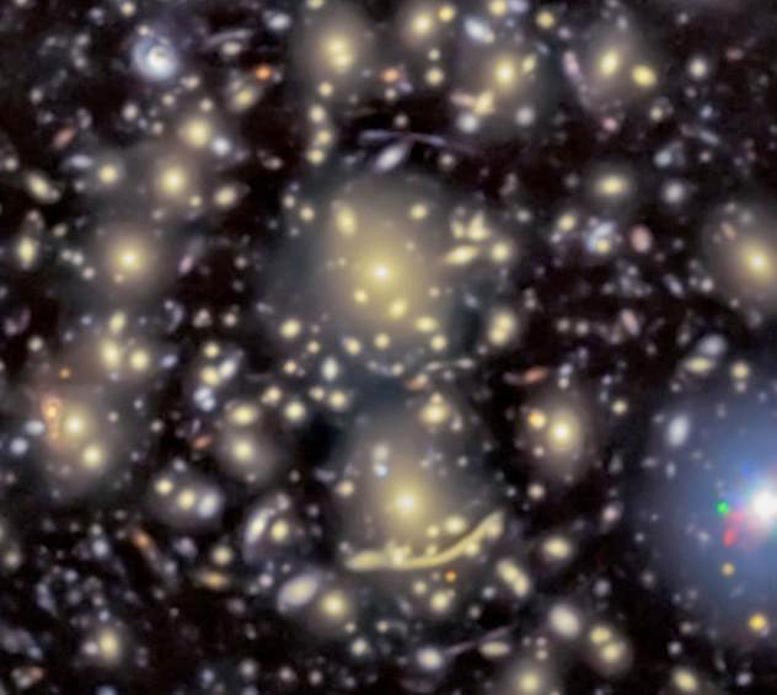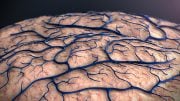New images have revealed detailed clues about how the first stars and structures were formed in the Universe and suggest the formation of the galaxy got off to a fitful start.
An international team of astronomers from the University of Nottingham and Centro de Astrobiología (CAB, CSIC-INTA) used data from the Hubble Space Telescope (HST) and the Gran Telescopio Canarias (GTC), the so-called Frontier Fields, to locate and study some of the smallest faintest galaxies in the nearby universe. This has revealed the formation of the galaxy was likely to be fitful. The first results have just been published in the journal Monthly Notices of the Royal Astronomical Society (MNRAS).
One of the most interesting questions that astronomers have been trying to answer for decades is how and when the first galaxies formed. Concerning the how, one possibility is that the formation of the first stars within galaxies started at a steady pace, slowly building up a more and more massive system. Another possibility is that the formation was more violent and discontinuous, with intense, but short-lived bursts of star formation triggered by events such as mergers and enhanced gas accretion.
“Galaxy formation can be compared to a car,” explains Pablo G. Pérez-González, one of the co-authors of the paper, affiliated to the Centro de Astrobiología (CAB/CSIC-INTA) in Spain, and principal investigator of the international collaboration behind this study. “The first galaxies might have had a ‘diesel’ star-forming engine, slowly but continuously adding up new stars, without much acceleration and gently turning gas into relatively small stars for long periods of time. Or the formation could have been jerky, with bursts of star formation producing incredibly large stars that disrupt the galaxy and make it cease its activity for a while or even forever. Each scenario is linked to different processes, such as galaxy mergers or the influence of supermassive black holes, and they have an effect on when and how the carbon or oxygen, that are essential for our life, formed.”
Using the gravitational lensing power of some of the Universe’s most massive galaxy clusters with the exceptional GTC data coming from a project entitled the Survey for high-z Red and Dead Sources (SHARDS) the astronomers searched for nearby analogs of the very first galaxies formed in the Universe, so that they could be studied in much more detail.
Dr. Alex Griffiths from the University Nottingham was one of the lead UK researchers on the study, he explains: “Until we have the new James Webb Space telescope, we cannot observe the first galaxies ever formed, they are just too faint. So we looked for similar beasts in the nearby Universe and we dissected them with the most powerful telescopes we currently have.”
The researchers combined the power of the most advanced telescopes, such as HST and GTC, with the aid of “natural telescopes.” Professor Chris Conselice, from the University of Manchester is a co-author on the study, he said: “Some galaxies live in large groups, what we call clusters, which contain huge amounts of mass in the form of stars, but also gas and dark matter. Their mass is so large that they bend space-time, and act as natural telescopes. We call them gravitational lenses and they allow us to see faint and distant galaxies with enhanced brightness and at a higher spatial resolution.”
Observations of some of these massive clusters acting as gravitational telescopes is the base of the Frontier Field survey. The study showed that the formation of the galaxy was likely to be stop-start with bursts of activity followed by lulls. Dr Griffiths from the University of Nottingham said: “Our main result is that the start of galaxy formation is fitful, like a jerky car engine, with periods of enhanced star formation followed by sleepy intervals. It is unlikely that galaxy mergers have played a substantial role in the triggering of these bursts of star formation and it is more likely due to alternative causes that enhance gas accretion, we need to search for those alternatives.
“We were able to find these objects due to the high quality SHARDS data coupled with imaging data from the Hubble Space Telescope to detect hot gas heated by newly formed stars in very small galaxies. This hot gas emits in certain wavelengths, what we call emission lines, just as a neon light. Analyzing these emission lines can provide an insight into the formation and evolution of a galaxy.”
“The SHARDS Frontier Fields observations carried out with GTC have provided the deepest data ever taken for discovering dwarf galaxies through their emission lines, allowing us to identify systems with recently triggered star formation,” adds Pérez-González, one of the co-authors of the paper and principal investigator of the GTC SHARDS Frontier Fields project.
Reference: “Emission Line Galaxies in the SHARDS Frontier Fields I: Candidate Selection and the Discovery of Bursty Ha Emitters” by Alex Griffiths, Christopher J Conselice, Leonardo Ferreira, Daniel Ceverino, Daniel Rosa-González, Marc Huertas-Company, Belén Alcalde Pampliega, Pablo G Pérez-González, Helena Dominguez Sanchez and Olga Vega, 20 October 2021, Monthly Notices of the Royal Astronomical Society.
DOI: 10.1093/mnras/stab2566










The Àuthors have a fertile trial about the theory of formation and evolution stars in the galaxies.Process of accretion of gas by super massive black hole is related to star formation is a true notion.ĺntervals of time
present between two serial star forming steps in early galaxies when first stars formed.The alternative causes in gas accretuon at event horizon of SMBH is present but to be defind by proper illustrations by mmore future discoveries.
Well, since Black Holes don’t exist that hypothesis is moot. But at least we’re starting to be drip-fed the evidence about the universe’s development over time…. just in time for the James Webb to confirm it.
Black hole shadows have been imaged [ https://en.wikipedia.org/wiki/Black_hole ].
… there, there, there…
Once again it seems fitful and that’s for real but seeing the movements from a space set point on a plane is still not telling us which way the area the camera sees is moving away or going the other way. That is from a parasitic point of view.
… Well, there is a question that is bothering me for a long time now.
There are particles, also known as virtual ones, that pop into our space time and as a pair they get lost. But what happens with the space time when that couple pops in.
Could that be the dark energy? …
No, those “virtual particles” are but temporary ripples and have nothing to do with dark energy as such. (Though they are an example of quantum field energy vacuum processes, so are related to vacuum “dark” energy.)
https://profmattstrassler.com/articles-and-posts/particle-physics-basics/virtual-particles-what-are-they/
“The term “virtual particle” is an endlessly confusing and confused subject for the layperson, and even for the non-expert scientist. I have read many books for laypeople (yes, I was a layperson once myself, and I remember, at the age of 16, reading about this stuff) and all of them talk about virtual particles and not one of them has ever made any sense to me. So I am going to try a different approach in explaining it to you.
The best way to approach this concept, I believe, is to forget you ever saw the word “particle” in the term. A virtual particle is not a particle at all. It refers precisely to a disturbance in a field that is not a particle. A particle is a nice, regular ripple in a field, one that can travel smoothly and effortlessly through space, like a clear tone of a bell moving through the air. A “virtual particle”, generally, is a disturbance in a field that will never be found on its own, but instead is something that is caused by the presence of other particles, often of other fields.”
… even as a virtual, those particles should have some effect to a space time, though.
Or is it a law that doesn’t apply to a particle world… It looks bit like that bridge in England when an engineers thought that walk will cancel out, but it did not…
… an explanation sounds, bit “dark”, better said “darkish”…
It might help if you thought of the Galaxies as being made up of the local concentration of the matirial that stars are formed out of. The galaxy ‘exists’ whether or not it’s first stars have yet lit, and it is the galaxys existence that brings the stars into existence themselves.
I see about 4 general ways a star could be built. The general concentration brought on by the galaxy. The push-away effect of a new star lighting. The remnents of a dead star being thrown into the void. And interaction with other galaxies. I hope you will mention the ways I missed. I will check back for a while. Thanks.
Well, the answer is that we don’t really know why these are bursty yet. Though the paper notes that they tend to be symmetric, which is evidence against mergers and your more general “interaction”.
There is a thread of galaxy studies that show how gas is continually recycled out and back in galaxies, which regulate star formation, so it could be that. Young galaxies may be like young stars, not yet stably working but having startup “hiccups”, but the paper didn’t speculate along those lines.
*into galaxies. And those recycling/star formation studies are also preliminary as of yet, AFAIK.
… you have a last word, but I would not say it…
… it is almost like something is boiling, observer can’t see it, after all… something like a different phase that will not be visible, or like a small shift and for sure has nothing to do with the forces. Pardon, a force carriers don’t have nothing to do with virtual particles, at all…
… and if something jumps there should be a reaction to it, and there is a oscillation and if some things get into a phase, that oscillation might get pretty interesting…
I am ever-perturbed by articles on galaxy formation. The authors always seem to imply that the galaxy’s matter would not coalesce into a galaxy unless stars formed. That seems nonsensical if not contrary to mass conservation. Stellar winds disperse the mass of gases that form galaxies. That dispersion might actually reduce the mass accumlated by the galaxy and (more importantly) theteby delay the gravitational collapse into an object we call a galaxy. “Science writers” keep repeating these fallacious implications and senior editors let them keep at it! WHY?